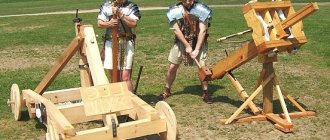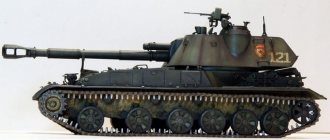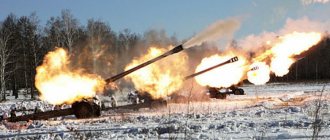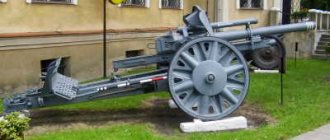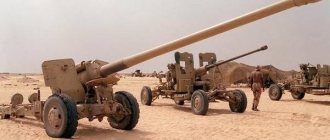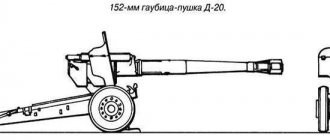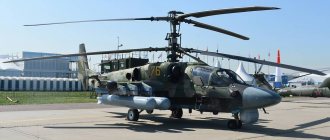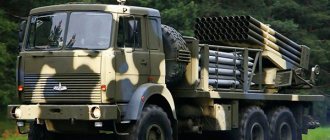In this article we will continue the story about the variants of the South Korean 155-mm self-propelled howitzer K9 Thunder, in particular, we will talk about export supplies of these artillery systems.
2017 was one of the most successful years in the history of exports of the K9 self-propelled howitzer: three contracts were concluded for the supply of this self-propelled gun - to Norway, Finland and India; the total amount of orders for self-propelled guns K9 and TZM K10 amounted to 720 million US dollars.
This success of South Korean arms export policy was preceded by painstaking, intense and lengthy work. Preparation of contracts lasted several years, and the K9 howitzer had to compete with all modern self-propelled guns.
CAESAR self-propelled guns from the French company Nexter are being tested in Norway.
In Norway
The history of Norway's purchase of the South Korean K9 self-propelled guns began back in 2007, when the country's armed forces began to work out a plan to replace the American-made M109 self-propelled guns that were in service. These machines, in the amount of 126 units, were purchased from Germany in 1969-1971. In the second half of the 1980s. they underwent modernization, after which they began to be designated as M109A3GN. In the second half of the 2000s. 24 vehicles were again modernized with the installation of new communication and navigation systems; they were given the designation M109A3GNM. In the process of reducing military spending after the end of the Cold War, only 24 such self-propelled guns were left in service with the country’s ground forces, and several dozen more vehicles were in storage. Despite modernization, by the beginning of the 2000s. M109A3GN no longer fully met modern requirements.
The Swedish armed forces had a similar need, planning to replace 24 VK155 self-propelled guns (in service from 1967 to 2003). The development of the concept of a new self-propelled gun in Sweden began in the mid-1990s. At first, the possibility of purchasing self-propelled guns abroad was considered (in particular, the German self-propelled gun PzH2000 from Krauss-Maffei Wegmann/Rheinmetall), but ultimately in Sweden they decided to develop their own self-propelled guns.
Self-propelled gun PzH 2000 of the German concern KMW undergoing testing in Norway.
According to the requirements for the new vehicle, it had to meet the NATO standard (155 mm howitzer with a 52-caliber barrel length), and also be able to use modular powder charges. The main developer was the Bofors company; the Volvo wheeled chassis was chosen as the base.
In 2003, a contract was signed with Bofors for the development of a new self-propelled gun project and for the production of two prototypes; in 2005-2006 they have passed a full cycle of tests. Based on their results, the project was continued to be finalized (the corresponding contract was signed in January 2007), and in September 2008, the Swedish Ministry of Defense officially announced its intention to purchase a new self-propelled gun, which received the designation FH77BW “Archer”.
Cooperation with Sweden within the framework of the program for the development, production and maintenance of a new self-propelled gun allowed Norway to reduce the costs of implementing its program. These countries already had successful experience in implementing similar projects: as part of military-technical cooperation with Sweden, Norway purchased 104 CV9030N infantry fighting vehicles (a variant of the Swedish CV90 infantry fighting vehicle), delivered in 1996-2000.
In November 2008, an agreement was signed under which Norway joined the project for the creation and mass production of the FH77BW Archer self-propelled gun; both countries pledged to purchase 24 self-propelled guns each. The new vehicles were planned to enter service in 2011.
However, the finalization of the self-propelled guns was delayed. According to reports in the foreign press, the performance characteristics of prototype Archer self-propelled guns did not fully satisfy the requirements of the Norwegian armed forces in terms of security, mobility and operational mobility. In December 2013, the Norwegian Ministry of Defense announced the suspension of its participation in the program (Norway spent about $65 million on its implementation).
The specific reasons for Norway's refusal to participate in the program were not disclosed in detail. It can be assumed that this was due to a number of factors. Thus, the use of the CV9030N infantry fighting vehicle by the Norwegian contingent in Afghanistan demonstrated its insufficient security, so in 2002 it was decided to increase this parameter (in 2003-2004, 17 vehicles were upgraded to the CV9030NF1 standard).
In addition, in Sweden in the late 1990s - early 2000s. developed new modular powder charges "Uniflex-21M", but Norway used modular charges DM 82/72 of the German concern Rheinmetall for field artillery, adopted by the Bundeswehr in 1996, and then by the armed forces of a number of other NATO states (including France, Italy , Greece, the Netherlands, Turkey). Norway, as a NATO member, for obvious reasons, refused to use Swedish modular charges.
Of course, the time factor and the need to further improve the design played an important role: the first four Archer self-propelled guns were delivered to the Swedish Army in September 2013, and they reached full combat readiness only on February 1, 2016. Probably, the Swedish leadership did not lose hope for the resumption of Norway’s participation in the program - only in 2016 was it decided to purchase 24 self-propelled guns for the Swedish Armed Forces, which were originally intended for Norway.
Tests of the first self-propelled howitzer K9 Thunder (Vidar), delivered to the Norwegian army, December 2022.
Already in 2014, the military-political leadership of Norway began to search for alternative options for equipping the ground forces with new 155-mm self-propelled guns. In the spring of 2015, a fundamental decision was made to purchase foreign self-propelled guns. The new artillery system had to meet a number of requirements: well-developed mass production, successful operation in the armed forces of several states, as well as higher security characteristics compared to the M109 self-propelled guns.
In April 2015, the Norwegian Ministry of Defense announced a tender for the supply of 24 modern 155-mm self-propelled guns with an option for another 24 units, and the purchase of TZM was also envisaged. The contract with the winning bidder was expected to be signed in mid-2022.
Four self-propelled guns took part in the competition: PzH2000 (Germany), K9 Thunder from Hanwha Techwin (South Korea), the American M109G modernized by Ruag Land Systems (Switzerland) and the wheeled self-propelled gun CAESAR (CAmion Equipe d'un Systeme d'Artillerie) from Nexter ( France). According to Hanwha Techwin, during tests in Norway, the K9 covered 720 km and fired 73 shots.
The tests were completed by the fall of 2016, with the K9 and M109G having the greatest chance of success, but the official results were not announced until the end of the next year. In 2016, the next stage (2013-2016) of the development program of the Norwegian armed forces, designed for the period until 2024, was completed; in connection with this, a plan was developed for the period 2017-2020, as well as a long-term plan until 2035. Changes in the military-political situation in the world, adjustments to NATO development plans and budget restrictions forced these plans to be adjusted, and their approval was delayed until mid-2022.
Ultimately, on December 20, 2022, the defense procurement agency, part of the Norwegian Ministry of Defense, entered into a package of agreements with the Korean company Hanwha Techwin worth NOK 1.8 billion (about $226 million).
Before the conclusion of the main contract, an industrial cooperation agreement was signed with South Korea in the defense sector: it is used as an important tool for stimulating the development of the Norwegian defense industry and is a mandatory element (with a number of exceptions) when purchasing weapons, equipment and technologies of defense significance abroad (if the country -the supplier is not a member of the European Economic Area or the European Union).
K9 self-propelled guns being tested in Norway.
The need to conclude an agreement on industrial cooperation is included in the terms of the announced tender, while the supplier company, when sending a proposal to supply weapons, military equipment, and equipment to the Norwegian armed forces, must also provide proposals on how cooperation will be carried out with enterprises and organizations of the Norwegian military-industrial complex.
The main contract for the supply of K9 self-propelled guns consisted of three parts:
– supply of 24 K9 self-propelled guns and six K10 TZMs, as well as an option for the supply of another 24 self-propelled guns; – a maintenance agreement, including the supply of the required number of spare parts and technical support by the supplier of the self-propelled guns and heavy equipment during the entire service life.
According to the terms of the contract and in accordance with the industrial cooperation agreement, the Norwegian company Kongsberg must supply and install on the K9 and K10 components of the ODIN automated artillery fire control system of its own design, which is in service with the Norwegian ground forces, and the equipment of the MARIA tactical automated combat control system. These self-propelled guns and TZMs use Norwegian-made radio communication systems and color video cameras for forward and rear viewing with image display on the driver’s monitor.
The total cost of the program, including the option, was approximately $380 million. The contract is valid until 2022, the delivery of the first batch of self-propelled guns was planned for 2022. It should be noted that the contract for the supply of TZM K10 was the first success of this vehicle on the foreign market.
As mentioned above, DM 82/72 and improved DM92 charges are used as the main modular charges for the 155-mm K9 self-propelled gun howitzer.
The Norwegian company Nammo carries out serial production of 155-mm high-explosive fragmentation projectiles (projectile mass - 42.5 kg, explosive mass - 9 kg, initial projectile speed - from 380 to 800 m/s, maximum range - 24 km), which are produced and in an inert version for training purposes, as well as HE-ER (High Explosive Extended Range) high-explosive fragmentation projectiles with a bottom gas generator and a firing range of up to 41 km (projectile weight - 44.4 kg, explosive weight (TNT) - 9 kg, initial speed - 935 m/s using six modular charges DM 72). In 2016, a new IM HE-ER (Insensitive Munition High Explosive Extended Range) projectile was developed, the main difference of which is greater resistance to external influences (fire, exposure to damaging elements, mechanical damage).
Norwegian self-propelled guns K9 and TZM K10.
In mid-February 2022, assembly of the first two self-propelled guns of the Norwegian order began at the Hanwha Techwin plant in the Changwon industrial zone. On September 19 of the same year, the company held a ceremony to display the K9 self-propelled guns and K10 TZM produced for Norway.
On November 24, 2022, the first two self-propelled guns and one heavy vehicle were delivered to Norway by sea. On December 4, these vehicles were officially handed over to the artillery division, which is part of the mechanized brigade “North” of the Norwegian ground forces. The self-propelled guns of the Norwegian order were called K9 VIDAR (Versatile InDirect ARtillery system - “indirect fire artillery system”, which fully corresponds to the type of howitzer). From December 2019 to February 2022, the self-propelled guns underwent a series of tests, including testing the reliability of production vehicles and their individual subsystems and assemblies in Norwegian conditions, and testing the operating efficiency of the ODIN control system.
To organize service maintenance of the new self-propelled guns and train crews and specialists for its maintenance and repair, a training and technical center was created in Norway.
In accordance with existing plans, the K9/K10 complexes must achieve full operational readiness no later than January 1, 2022.
Operators[edit]
| This section requires additional links for verification . |
Map of M114 operators in blue with former operators in red
Current operators[edit]
- Afghanistan: 24 as of 2016 [5][Update]
- Argentina: 6 as of 2016 [6][Update]
- Brazil: 95 in the Army and 8 in the Marine Corps as of 2016 [7][Update]
- Ecuador: 12 as of 2016 [8][Update]
- El Salvador: 6
- Greece: 206 as of 2016 [9][Update]
- Iran: 70 as of 2016 [10][Update]
- Jordan: 18 as of 2016 [11][Update]
- Laos: 12 as of 2016 [12][Update]
- Lebanon: 18 as of 2016 [13][Update]
- Mexico
 [14]
[14] - Morocco: 20 as of 2016 [15][Update]
- Myanmar: 100 in service [16]
- Pakistan: 144 in service with the Pakistan Army. [17] [18]
- Peru: 36 as of 2016 [19][Update]
- Philippines [20]
- Portugal: 24 as of 2016 [21][Update]
- Saudi Arabia: 50 as of 2016 [22][Update]
- South Korea [23]
- Sudan: 12 as of 2016 [24][Update]
- Taiwan: 250 as of 2016 [25][Update]
- Thailand: 48 as of 2016 [Update], [26] in reserve
- Tunisia: 12 as of 2016 [27][Update]
- Türkiye: 517 as of 2016 [28][Update]
- Uruguay: 8 as of 2016 [29][Update]
- Venezuela: 12 as of 2016 [30][Update]
- Vietnam [31]
Former operators[edit]
- Austria [ link needed
] - Belgium
- Khmer Republic
- Canada
- Croatia
- Denmark [32]
- France
- Israel
- Italy [32]
- Japan
- Libya
- Norway [32]
- Netherlands [32]
- Singapore
- Spain [32]
- USA [32]
- Yugoslavia (passed to successor states)
In Finland
Finnish Armed Forces since the late 1990s. planned to update the self-propelled gun fleet. In 2008, the total number of guns in the Finnish ground forces was about 770 units, including 72 122-mm self-propelled guns 2S1 "Gvozdika" (Finnish designation 122 PSH 74), purchased in 1992 from the army of the former GDR, 18152- mm self-propelled guns 2S5 "Gyacinth", 684 towed artillery systems, including about 400 towed 122-mm howitzers D-30, 36 130-mm cannons M-46, 180 152-mm howitzers N 88-38 and N 88-40a, as well as 56 155-mm towed howitzers K 98. The 155-mm howitzer K 98 with a barrel length of 52 calibers, equipped with an auxiliary power unit, was developed and put into mass production by the Finnish company OyTampella AB industries; supplies to the Finnish armed forces were carried out in the late 1990s - early 2000s.
155-mm K9 self-propelled howitzer being tested in Finland, November 2016. The vehicle does not have an APU.
In the early 2000s. Finland conducted preliminary negotiations on the possibility of purchasing German PzH 2000 self-propelled howitzers, but financial restrictions forced it to abandon the contract.
In 2014, Finland began implementing a program to increase the combat capabilities of field artillery, which included replacing outdated types of artillery systems with modern self-propelled guns with an increased firing range, improved mobility and security with the possibility of operation until 2050. According to the conclusions of Finnish experts, these requirements are most relevant corresponded to a 155-mm self-propelled gun on a wheeled or tracked chassis.
At the next stage of the project, Finland sent official requests for information on the possibility of supplying new 155-mm self-propelled guns to a number of states and manufacturing companies. The Norwegian tender gave Finland the opportunity to familiarize itself with the results of comparative tests of various self-propelled guns in Norway without organizing its own tender. In addition, the purchase of K9 self-propelled guns by Norway allowed Finland to reduce the cost of technical support for the operation of self-propelled guns by sharing available resources. It was also important that Finland, not being a member of NATO, pursues a policy in the military sphere aimed at achieving the maximum level of compliance of its armed forces with NATO standards, and the K9 self-propelled gun fully satisfied these requirements.
During the visit of the official delegation of the Finnish Armed Forces to the Republic of Korea in the summer of 2016, she was given the opportunity to visit one of the artillery units of the ground forces of the Republic of Korea, equipped with a K9 self-propelled gun. The delegations demonstrated the dynamic and fire capabilities of self-propelled guns and TZM K10. As a result, the country’s leadership decided on the need to test the South Korean K9 howitzer, which took place in Finland in the fall of 2016.
Following the visit of the above-mentioned delegation in July 2016, negotiations were officially announced in Finland with South Korea on the acquisition of K9 Thunder self-propelled howitzers from the armed forces of the Republic of Korea.
In February 2022, the Finnish Ministry of Defense, through the mediation of the South Korean state-owned non-profit trade and investment promotion organization KOTRA, entered into a contract with Hanwha Corporation for the supply of 48 K9 self-propelled guns from the armed forces of the Republic of Korea for a total amount of about 146 million euros (160 million US dollars), including the cost of training specialists, supply of spare parts and service support. Delivery should be made between 2022 and 2024.
K9 self-propelled guns of the Finnish ground forces.
Before being sent to Finland, the K9 undergoes repairs and modernization at the Hanwha Land Systems company, including the installation of an auxiliary power unit; in Finland, a 12.7-mm NSVT machine gun is installed on the commander’s cupola. The first batch of four K9s arrived in Finland in February 2022.
The self-propelled gun, which was tested in Finland in November 2016, remained at the disposal of the Finnish armed forces, where it was used to further study the capabilities of the vehicle and took part in military parades and exhibitions, in particular, in the military parade in Helsinki in honor of Armed Forces Day on June 4 2022
K9 self-propelled guns of the Finnish ground forces in a firing position.
In 2022, the Finnish ground forces had 36 self-propelled guns 2S1 (Finnish designation PsH 74), 4 self-propelled guns K9, 234 towed howitzers D-30 (N 63), 54 155-mm howitzers K 98 and 36 130-mm cannons M-46 ( K 98). According to the plan to equip the Finnish armed forces with K9 howitzers, after the arrival of the first batch of self-propelled guns, training of crews from among conscripts will begin, and the first artillery battery equipped with the new systems was supposed to enter combat service in 2022.
In Estonia
Since 2015, Estonia has been carrying out measures aimed at increasing the combat capabilities of the armed forces, with particular importance attached to strengthening the ground forces. In this regard, it was planned to strengthen the artillery of the ground forces, the main weapon of which in the 1990s - 2000s. were 24 155-mm towed howitzers FH 70, purchased from Germany, as well as Soviet 122-mm towed howitzers D-30, transferred by Finland.
One of the first two K9 Thunder Tana self-propelled howitzers received by Estonia, 10/09/2020 Estonian Armed Forces
The tender conducted by Norway for the acquisition of a new self-propelled gun and Finland’s development of a project for the purchase of the K9 self-propelled gun aroused the quite natural interest of the Estonian leadership: in the official statement of the Finnish Ministry of Defense dated February 17, 2022, the planned purchase of the K9 was also reported on the exchange of information with Estonia on this issue. Joining the K9 procurement process by Finland allowed Estonia to significantly save time and money spent on testing, coordination of technical issues and preparation of the contract. In June 2022, the State Defense Investment Center of the Ministry of Defense of Estonia (RKIK) signed a contract worth 46 million euros with the South Korean state foreign trade association KOTRA and the Hanwha Corporation for the acquisition of 12 K9 Thunder self-propelled howitzers from the South Korean army with an option for the possible purchase of 12 more such Self-propelled guns.
Read: M151 vehicle - multi-purpose tactical truck
In accordance with the terms of the contract, the purchased 12 K9 self-propelled guns must be delivered to Estonia in several batches, starting in 2020 (delivery of the first two vehicles). Before delivery, the K9 must be repaired and upgraded to K9A1 level at the Hanwha Land Systems plant.
In August 2022, Estonia, within the framework of the option mentioned above, entered into a contract for the purchase of six more K9 self-propelled howitzers, ammunition and additional equipment for a total amount of 37 million euros. As Estonian Defense Minister Jüri Luik noted in an interview with the Estonian newspaper Postimees in October 2022, their acquisition was made possible by freeing up additional funds in the amount of about 20 million euros due to savings on procurement of the Estonian Ministry of Defense in 2022.
At the end of August 2022, the first two self-propelled guns arrived in Estonia, which are expected to be used for training personnel; their transfer to the troops is planned for 2022. Initially, it was planned to equip the artillery division of the 1st Infantry Brigade with two artillery batteries of six K9s each. As a result of the purchase of six more self-propelled guns, there will be three such batteries in the mentioned division.
According to Hanwha, despite concerns expressed in foreign media regarding possible delays in delivery of the above-described contracts due to the COVID-19 pandemic, deliveries will be carried out in strict accordance with schedule.
User nations
- Afghanistan
- Argentina
- Brazil
- Cambodia
- Canada
- Chile
- Denmark
- Ecuador
- Philippines
- France
- Greece
- Iran
- Iraq
- Israel
- Italy
- Jordan
- Yugoslavia
- Lebanon
- Libya
- Norway
- Pakistan
- Portugal
- Saudi Arabia
- Serbia
- Singapore
- South Korea
- South Vietnam
- Taiwan
- Thailand
- Türkiye
- Uruguay
- USA
- Venezuela
- Vietnam
- Austria
Indian tender
In the early 1980s. The leadership of the Indian armed forces, which possessed a significant number of various artillery systems, began to address the issue of standardization and increasing the combat capabilities of artillery. The first step was an agreement with the Swedish on the acquisition of a large batch of 155-mm towed (self-propelled) self-propelled guns FH 77B with a barrel length of 39 calibers. Deliveries have been carried out since the second half of the 1980s.
K9 self-propelled howitzer being tested in India.
In 1990, the Indian ground forces were armed with about 3,900 towed guns (including 50 FH 77B units) and 180 self-propelled artillery; the latter included about 80 105-mm self-propelled guns made in England by Abbot and about a hundred 130-mm Soviet-made guns mounted on the chassis of the Vijayanta tank. By 2000, the composition of self-propelled artillery had not changed fundamentally; the amount of FH 77B was about 400 units.
In the 1990s. The Indian leadership paid considerable attention to the development of military-technical cooperation with South Africa, including in the development of artillery systems, ammunition and powder charges. In 2002, a number of contracts were signed with the South African company Denel to produce the M90 modular artillery charge system for India and to organize their mass production there (in total, it was planned to produce 400 thousand modular charges of two types in the country). However, due to sanctions against Denel imposed by the Indian government in 2005, the contract was terminated. By this time, the Indian side had accepted 87,750 charges from the manufacturing company; another 90,500 charges were not officially accepted.
In March 2009, it was decided to continue work on the production of modular charges together with the Israeli company IMI, but this contract, for a number of reasons, was not developed. Subsequently, India decided to independently produce modular charges based on the obtained technologies; their production began in 2011.
Denel also participated in the project to create a modern 155-mm self-propelled gun on the chassis of the promising main battle tank of the Indian design Ardjun, being responsible for the artillery part and the loading mechanism. Testing of the new self-propelled guns took place in 1999-2000, but the delay in organizing the production of the Ardjun MBT and the same sanctions against Denel froze the project.
In 2001, India, as part of increasing the combat capabilities of its ground forces, concluded a large-scale contract with the Russian Federation for the supply of a batch of Russian-made T-90 main tanks with the subsequent organization of their licensed assembly and mass production at Indian enterprises. Note that the country's ground forces were equipped with BMP-2 infantry fighting vehicles; The USSR transferred the license for their production to India in 1984 (in 2000, the country's ground forces had about 1000 BMP-2 and vehicles based on it). Thus, the armored divisions had modern tanks and infantry fighting vehicles, but self-propelled artillery did not provide These formations require the necessary level of combination of firepower and operational mobility.
Consideration of the issue of purchasing a new self-propelled gun began in the mid-1990s. However, the process of approving the program for updating the fleet of self-propelled and towed artillery proceeded rather slowly - in the traditions of the Indian defense department, although it was somewhat intensified by the Indo-Pakistani conflict in the high mountainous Kargil region in 1999. A more serious incentive was the purchase by Pakistan of 115 American-made M109A5 self-propelled guns: in 2005 The government of Pakistan submitted an official request to the United States for the possibility of purchasing the specified number of self-propelled guns, spare parts, repair kits, equipment for servicing and monitoring the condition of vehicles, as well as organizing training for crews and maintenance specialists. The deal was approved: from 2006 to the beginning of 2010, 115 modernized self-propelled guns were delivered to Pakistan.
In this situation, the Indian military-political leadership intensified the program for modernizing the artillery of the ground forces. Already in January 2011, the Indian Ministry of Defense sent official requests to the world's leading manufacturers for proposals for the supply of self-propelled guns with a caliber of 155 mm and a barrel length of 52 calibers. The terms of the proposed contract contained requirements for organizing the production of self-propelled guns in India, while the foreign supplier had to work out in advance the fundamental and technical issues of serial production with a specific Indian partner company and must necessarily adapt the self-propelled gun project to the specific requirements of the country's armed forces (use in hot weather). and dry desert climates and mountains). In addition, it was necessary to provide for the use of a number of Indian-made subsystems, including fire control systems, communication and navigation systems, as well as the mandatory use of modular charges of the Indian-made M90 system.
According to foreign press reports, technical and commercial proposals were submitted by the following with a 155-mm self-propelled gun 2S19M1, the Swedish Bofors with a wheeled self-propelled gun, the French Nexter, the South Korean Samsung Techwin with a K9 tracked self-propelled gun, and the Israeli Soltham with a wheeled self-propelled gun project. The German concern Rheinmetall proposed projects for the 155-mm wheeled self-propelled gun Rheinmetall Wheeled Gun (RWG)-52 and the tracked Rheinmetall Tracked Gun (RTG)-52 - both vehicles used a turret and an artillery unit developed on the basis of technologies used in the design of the German PzH 2000.
Russian and South Korean self-propelled guns were selected to participate in the second stage of the competition. The vehicles have undergone intensive testing in various climatic conditions in India since 2012, and at the end of 2015 the victory of the South Korean machine was officially announced.
Over the next two years, the terms of contracts for the purchase of K9 self-propelled guns were negotiated and worked out. The partner of the South Korean company (in accordance with the procurement procedures in force in India) was the large diversified Indian concern Larsen & Toubro (L&T). In March 2022, the Security Committee of the Government of India approved the purchase of 100 vehicles, designated Vajra-T (the name “Vajra” in Hinduism and Buddhism is a ritual and “divine” weapon that combines the properties of a sword, mace and spear; “T” means Tracked, i.e. tracked chassis). The following month, L&T awarded Hanwha Techwin a contract to co-produce the K9. Finally, on May 12, 2022, L&T signed a contract with the Indian Ministry of Defense for the supply of 100 units of 155 mm/52 K-9 Vajra-T self-propelled howitzers with a total value of 45 billion Indian rupees (about $700 million). The agreement provides for the delivery of 100 units over 42 months, as well as an accompanying maintenance package, including the transfer of howitzer maintenance technologies.
The first batch of ten K9 Vajra-T manufactured by Hanwha Techwin was expected to be delivered within 11 months from the date of signing the contract. The remaining 90 self-propelled guns should be assembled at the newly built production complex of the L&T concern in Hazira (a port city in the state of Gujarat). The production complex provides a full cycle of serial production and testing of self-propelled guns. In the future, this complex is expected to be used in the production of combat vehicles under the Future Infantry Combat Vehicles (FICV) and Future Ready Combat Vehicles (FRCV) programs. Delivery of all 100 self-propelled guns was planned to be completed within 42 months (by November 2020).
In addition to serial production of self-propelled guns, L&T produces a number of critical subsystems and enters into agreements with manufacturers in India for the supply of necessary components. L&T is responsible for manufacturing the hull, turret, ammunition feed mechanism and fire control system. Other enterprises of the Indian defense industry supply the following systems: the BEL FOG navigation system, night vision devices (including a thermal imaging device for monitoring the driver), the STARS-V Mk 3 radio communication system, radiation, biological and chemical protection systems, fire protection equipment, gunner's sight, auxiliary power installations, air conditioning systems, inertial navigation system and GPS receiver, equipment for measuring the initial velocity of the projectile. According to Indian press reports, five enterprises belonging to the L&T concern are involved in the serial production of self-propelled guns, and more than 400 Indian companies supply various units, components and components (more than 13,000 items).
As in the SPG version for Finland, the Vajra-T is armed with a 12.7 mm NSV machine gun on the commander's cupola.
The terms of the contract provide for the organization of service maintenance and all types of repairs of the K9 at the L&T enterprise during the entire period of operation of the self-propelled guns. At the same time, Hanwha Techwin provides assistance in training relevant engineering and technical personnel.
New machines are undergoing a cycle of factory tests at the test site, which is part of the production center in Hazira. The tests include running the self-propelled guns over a distance of up to 100 km and testing the performance of all main subsystems. The vehicle is then handed over to military acceptance representatives, who carry out their test cycle (also on the plant's test track), after which it is handed over to the Indian Armed Forces.
On November 9, 2022, at the artillery range in Deolali, an official ceremony was held for the inclusion of the first batch of ten 155/52 mm K9 Vajra-T self-propelled howitzers into the combat strength of the Indian ground forces. At the same time, it was announced that the first artillery regiment, fully equipped with new vehicles, would reach full combat readiness by July 2022 (the organizational structure of the artillery regiment provides for the presence of 18 self-propelled guns).
On January 19, 2022, Indian Prime Minister Narendra Modi took part in the official roll-out ceremony of the first K9 howitzers manufactured in India. In November of the same year, an artillery regiment equipped with such self-propelled guns took part in exercises conducted in the Thar Desert. At the same time, a scenario was worked out for conducting combat operations in the area of a conditional state border with repelling an enemy offensive, during which massive artillery and missile strikes are carried out on it, followed by crossing the border by armored formations, encircling and defeating the enemy group. Up to 40 thousand military personnel, 700 armored combat vehicles, 300 artillery systems with aviation support took part in the exercises.
In other countries of the world
Between 2000 and 2022. The K9 self-propelled gun was actively promoted on the global arms market. According to calculations by the Stockholm Peace Research Institute, from 2000 to 2022. These vehicles accounted for 48% of the world's supplies of self-propelled artillery units. In addition to the countries mentioned earlier, the K9 was tested in Egypt, Australia, Malaysia, and was also offered to a number of countries in the Middle East and Southeast Asia.
On September 3, 2022, the Australian Department of Defense sent an invitation to Hanwha Defense Australia to participate in a tender for the supply of self-propelled guns for the Australian ground forces. This decision actually means the victory of the South Korean self-propelled guns in the next tender.
The history of the procurement of self-propelled guns for the Australian armed forces began almost a decade ago, when, as part of the Land 17 Phase 1C project, it was planned to purchase 18.24 or 30 self-propelled guns to replace the 36 towed 155-mm M198 howitzers with a barrel length of 39 calibers supplied from the United States that were in service. However, due to financial restrictions, this part of the project was canceled in 2012. In return, the Australian ground forces received in 2011 (also from the USA) 35 light 155-mm towed howitzers M777A2 and an additional 19 more of the same systems after the cancellation of the Land 17 Phase 1C project .
The main participants in the tender were the South Korean company Samsung Techwin in partnership with the Australian Raytheon Australia, which presented the AS9 project (Aussie Thunder - “Australian Thunder”), and the German consortium Kraus-Maffei Wegmann in partnership with BAE Systems Australia - with the PzH2000 self-propelled guns.
In May 2022, the Australian government announced its intention to purchase 30 self-propelled guns as part of another project aimed at increasing the capabilities of the country’s ground forces (Project Land 8116 Phase subprogram Protected Mobile Fires), and at the same time the competencies of its own industry. According to the requirements of the project, the production of self-propelled guns must be carried out in cooperation with Australian enterprises (Australian Minister of Defense Industry Linda Reynolds, who soon became Minister of Defense, linked this to the “smart buyer concept”).
By the time the new tender was announced, Samsung Techwin (manufacturer of the K9 self-propelled guns) had been absorbed by the Hanwha Techwin consortium. The project of an improved self-propelled howitzer (received the name Huntsman - “hunter”) was presented for participation in the new competition by Hanwha Defense Australia, which is also participating in the competition for the supply of infantry fighting vehicles for the Australian ground forces.
It is planned to purchase 30 self-propelled guns and 15 heavy equipment for a total amount of 1.5 billion Australian dollars (about 950 million US dollars). Thus, Australia will become the second foreign recipient of K10 TPM after Norway.
The supply of self-propelled guns and heavy equipment must be carried out in batches; the final batch is planned to be transferred in 2023-2024. By 2025, the troops should receive two regiments equipped with new self-propelled guns. By 2030, it is planned to purchase a second batch of howitzers as part of Project Land 8116 Phase 2 for a total amount of 1.5 to 2.3 billion Australian dollars. After 2030, the Ministry of Defense Australia plans to modernize purchased self-propelled guns as part of the third phase of the same project.
As mentioned above, production, maintenance, all types of repairs and modernization of self-propelled guns and heavy equipment must be carried out at the Hanwha Defense Australia enterprise, built in Australia in cooperation with Australian industry enterprises.
Thus, Hanwha Techwin, in partnership with the South Korean Defense Development Agency and enterprises of the South Korean military-industrial complex, continue to work on modernizing the K9 and promoting its variants to the world market. Thus, it is planned that this self-propelled gun will participate in the tender for the supply of new self-propelled guns for the British ground forces.
Ammunition
The gun had a separated projectile and charge. There were seven different charges ranging from 1 (smallest) to 7 (largest). Mouth speed, range and penetration in the tables below are for the largest M4A1 grenade loads.
| Grenades [3][4] | |||||
| Type | Model | Projectile weight, kg | Charger | Mouth rinsing speed, m/s | Range, m |
| HE M102 projectile | 43,13 | TNT, 7.06 kg | |||
| HE M107 projectile | 43 | TNT, 6.86 kg | 564 | 14.955 | |
| Smoke | FS M105 Projectile | 45,14 | sulfur trioxide in chlorosulfuric acid, 7.67 kg | ||
| Smoke | WP M105 Shell | 44,55 | white phosphorus, 7.08 kg | ||
| Smoke | FS M110 Projectile | 45,45 | sulfur trioxide in chlorosulfuric acid, 7.67 kg | ||
| Smoke | WP M110 Shell | 44,63 | White phosphorus, 7.08 kg | ||
| Colored smoke | BE M116 Projectile | 39.21 | Smoke mixture 7.8 kg | ||
| Smoke | Housing HC BE M116 | 43,14 | Zinc chloride, 11.7 kg | 564 | 14.955 |
| Gas | Housing CNS M110 | 44,05 | phenylacetyl chloride, 6.26 kg | ||
| Gas | Housing H M110 | 43,09 | mustard gas, 5.02 kg | 564 | 14.972 |
| Light | M118 illumination round | 46,77 | lightweight, 4.02 kg | ||
| Exercise | Dummy Mk I Shell | — | — | — | |
| Exercise | M7 projectile dummy | 43,09 | — | — | — |
| Shotguns[3] | ||||
| Model | Total weight, kg | Components | ||
| M3 | 2,69 | Basic board and four additional charges (from 1 to 5) | ||
| M4 | 6,29 | Basic board and two additional boards (5 to 7) | ||
| M4A1 | 6,31 | Base charge and four additional charges (from 3 to 7) | ||
| Dummy Mk I | 3,63 | Basic fee and six additional fees | ||
| Mannequin M2 | 3,34 | Basic fee and six additional fees | ||
| Concrete penetration, etc. [4] | ||||
| Ammunition range, m | 0 | 914 | 2743 | 4572 |
| HE M107 projectile (0° incidence angle) | 884 | 792 | 610 | 488 |
| Different countries/periods used different measurement methods. Therefore, direct comparison is often not possible. | ||||
